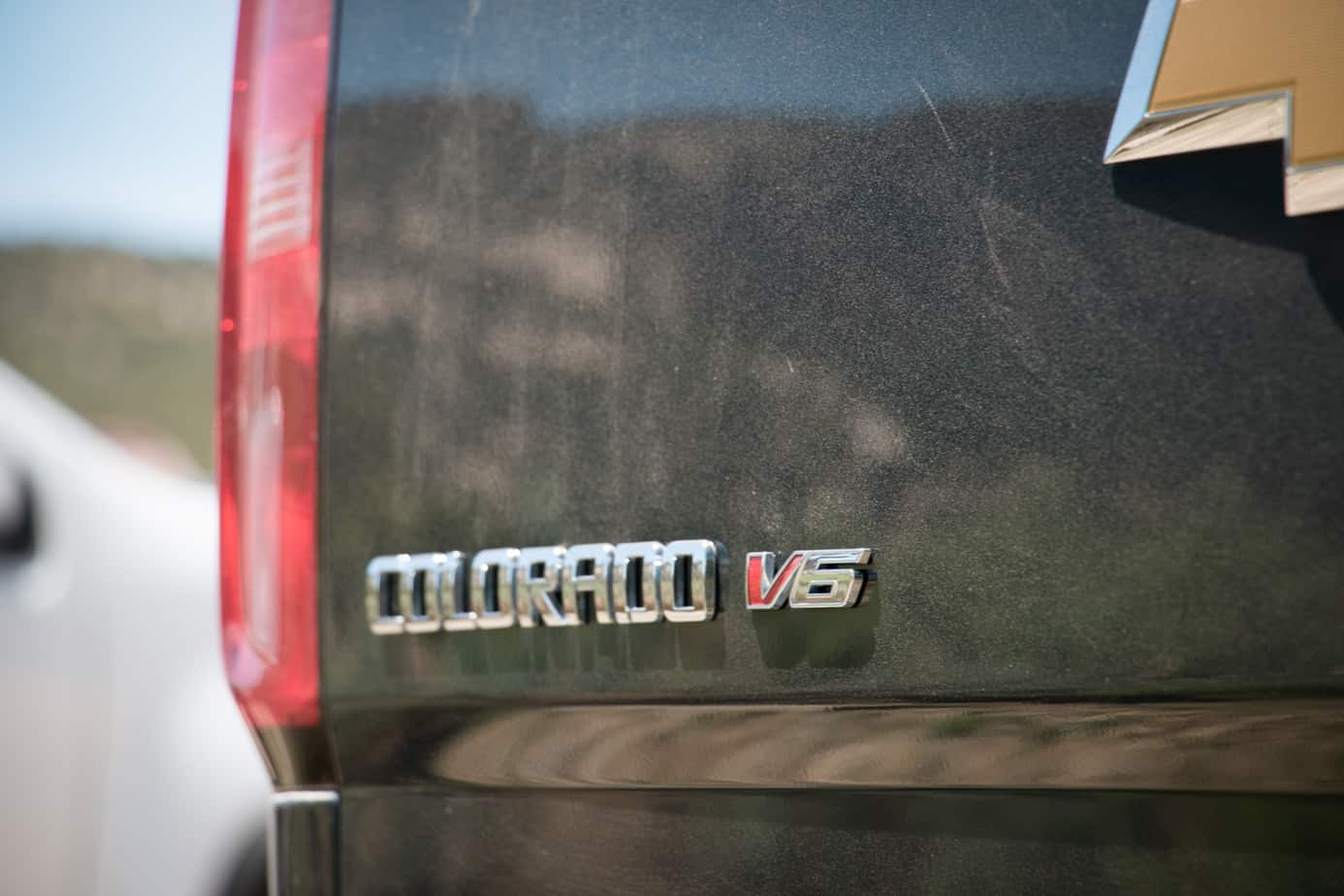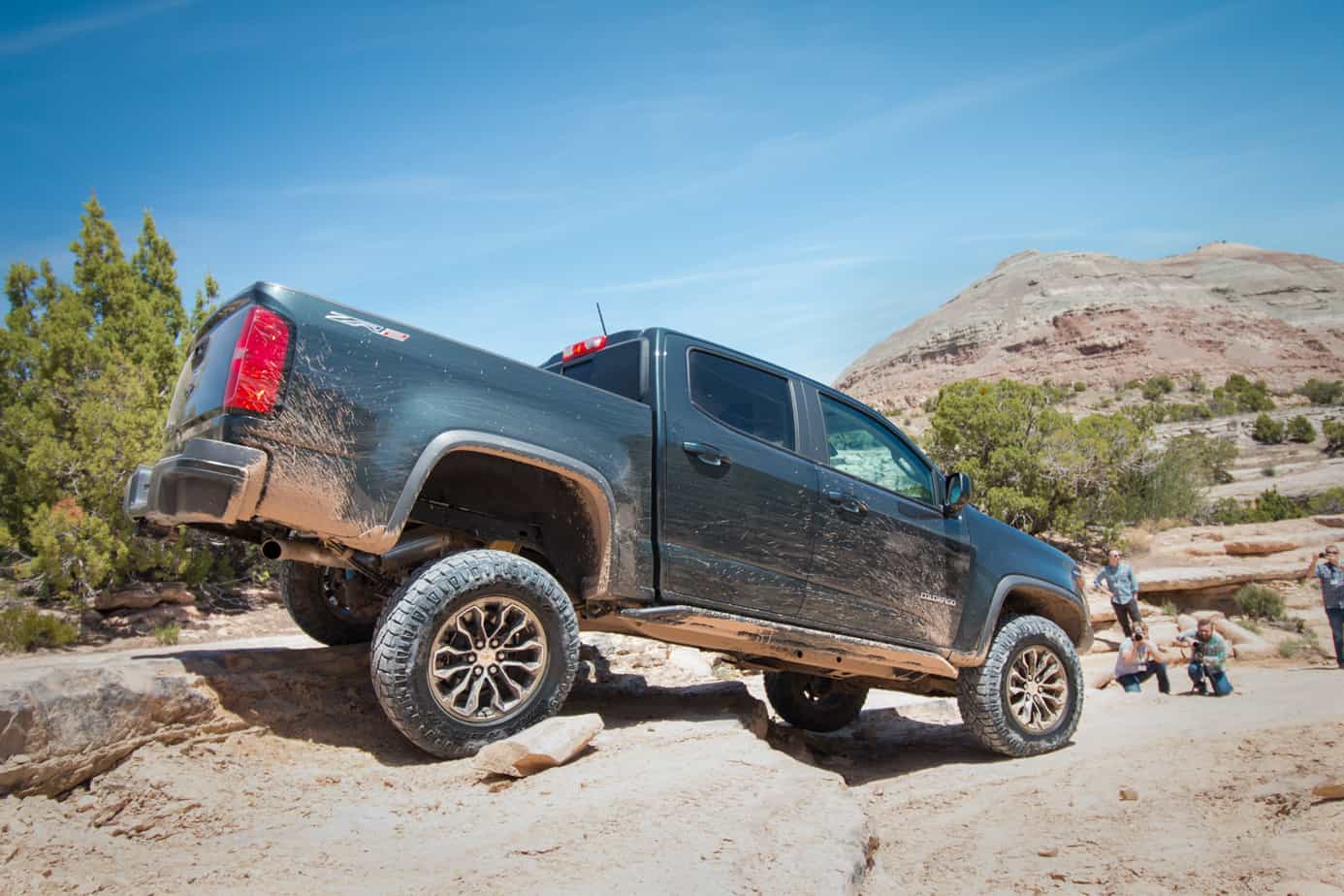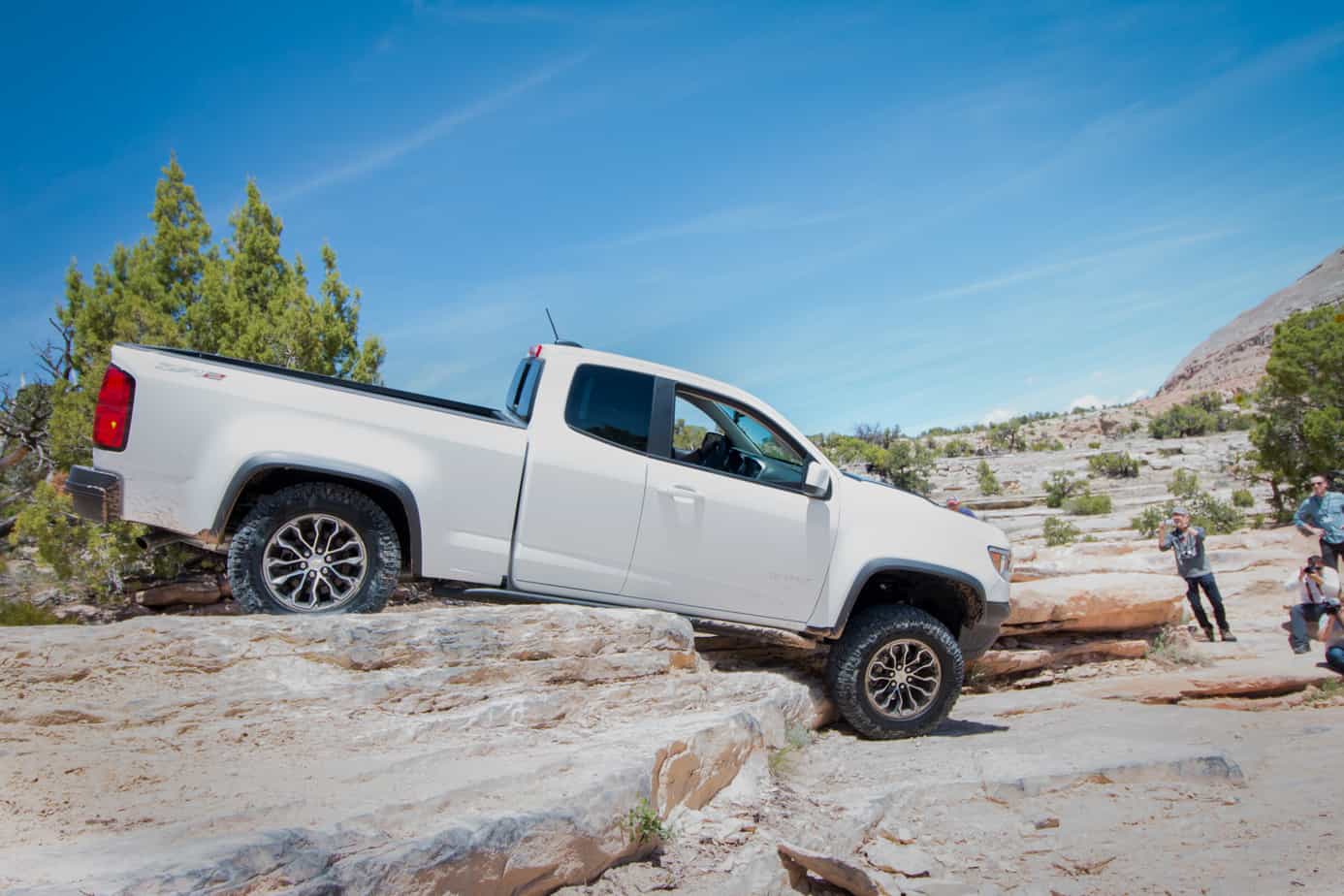Sand soared off the tires in a wide arc as we rounded the first bend of the track. “Give it some more throttle,” the instructor urged as we entered a straight. The ZR2 flew over the heavy corrugations with ease as I hit the brakes hard before diving into the next left. As we slid out of the corner to the sound of a spooled 2.8L Duramax, I noticed a sharp rise in the track ahead. Once again the instructor urged me to “hit it with some speed.” So, I did. Houston we have liftoff. All four tires rocketed off the ground, and something between a four letter word and a laugh escaped my mouth. Manufacturers don’t usually allow you to jump their trucks. With a cloud of dust the tires reconnected with the dirt once more and I punched the accelerator to go do it again.

Last year we asked General Motors to lend us a brand new Duramax Z71 Colorado for a week of trails, camping, and general off-road use. To our great excitement, Chevrolet accepted, and we spent 7 days getting to the core strengths and weaknesses of the truck. (You can read about it here) For the most part, we loved the spunky mid-size, but it wasn’t the category dominator we had hoped for. It lacked proper lockers, the traction control didn’t accommodate left foot braking, and it needed a skid plate or additional clearance before any rock crawling became feasible. But then something interesting happened: Chevrolet announced the ZR2. On paper it seemed to be the answer to every concern we had. In fact, the spec sheet read like a North American overlander’s wish list: 2-inch lift, all-terrain tires, factory sliders and skid plates, front and rear lockers, optional diesel motor. The only question was, how would it actually perform? After 2 days on Colorado trails, an off-road race track, and twisting highways, we have our answer.

Suspension
The ZR2 is packed with off-road goodies, but the game changer is the new 2-inch Multimatic DSSV suspension lift. The DSSV, or Dynamic Suspensions Spool Valve, uses a series of spring-loaded valves that open and close at varying rates depending on the speed of the internal shaft. This controls the flow of oil through the shock, and allows engineers to optimize several distinct damping curves for different rates of compression and rebound. This concept of velocity-sensitive damping isn’t new, but up until now it had only been used on high-performance road cars like the Aston Martin One-77, Mercedes AMG GT, and Red Bull’s Formula One car. In order for it to be applied to an off-road vehicle, Multimatic had to make it position sensitive by adding a third spool valve to the shock, which gives the body its unusual shape. This third valve is only activated under extreme compressions, and allows the suspension to handle jumps and other large impacts without bottoming out.

So what does this mean for overlanders? In layman’s terms, the DSSV system eliminates the compromises of traditional suspensions. You no longer have to choose between having a bypass shock for aggressive off-road handling, or running a standard suspension for good road manners because the Multimatics can provide both without any adjustments. It sounds too good to be true, but after two full days on high speed dirt tracks, twisty highways, and technical terrain, I can say it’s the real deal.

On heavy corrugations the truck was surprisingly smooth, with little interior vibration compared to the abuse being absorbed by the suspension. Cornering was excellent, and even when pushing the ZR2 to the point of losing traction, it felt composed and predictable. Despite hours of track use, aggressive driving, and no less than 18 jumps from each journalist, we experienced no perceptible heat fade in the shocks—a welcome side effect of using spool valves, which are largely unaffected by temperature.

In extreme compression situations (aka jumps), I was blown away by how effortlessly the ZR2 landed. Even when I accidentally hit the crest with too much speed, the return to earth was smooth with a quick return to a neutral position.

After experiencing such great performance in the dirt, I hadn’t expected much from the road handling, so you can imagine my surprise when I took the first highway corner without a hint of body roll. With each subsequent s-turn I pushed the ZR2 faster, until suddenly (with a big smile on my face) I realized that I was driving it more like a sports car than a truck. Trying not to seem overly excited in front of my fellow journalists, I remarked “impressive.” and mashed the accelerator out of the next hairpin turn.

The only area where I felt the DSSV fell short was on slow-speed trails with embedded rocks. This is a common weakness for suspensions, as it requires a very soft system, which tends to be unstable during daily driving and high-speed use. Even so, the Colorado didn’t perform poorly in this category; it was simply on par with what I would expect from any other suspension.

Trail Performance
The other huge upgrade to the ZR2 is the addition of front and rear electronic lockers. We mentioned in our last article on the Z71 that the G80 auto-locker had difficulty engaging at low speeds, so we were thrilled to see they had remedied that situation with these manually engaged units. On the rocks they performed flawlessly, and made challenging ledges seem like a cakewalk. Engagement was smooth and straightforward, and several journalists who had never driven off-road were able to scale the obstacles without issue. You can even engage the rear locker in 2WD at any speed, so for those who liked the G80 for fast desert tracks, you won’t be disappointed.

Two of the Z71’s bigger problems were the terrible approach angle and vulnerability of components to rocks, both of which have been addressed in the ZR2. In addition to the 50 millimeters (2 inches) of lift provided by Multimatic’s DSSV, the new Colorado has ditched the lower air dam for a high- clearance alternative, which brings the approach angle from 17.3 degrees to a respectable 30 degrees. Departure angle is up from 22.1 degrees to 23.5 degrees, and the breakover has increased from 19.8 degrees to 23.5 degrees, with a total of 8.9 inches of ground clearance at the lowest point (beneath the rear shocks).

With this additional clearance we were far less concerned about trail damage, but accidents happen, so we’re glad to see that Chevrolet did a considerable upgrade to their protection package. In the front, a 4-millimeter aluminum skid plate was bolted into place to shield the radiator and engine oil pan, while a 3-millimeter aluminum skid was used to protect the transfer case further aft. There’s also a set of full-length sliders included as a standard feature, which is really going the extra mile. We only saw these put to use once during our evaluation, but they took the hit without flinching, and carried the ZR2 down the ledge while keeping the rocker panels safe.

Engine Options
The 2017 ZR2 comes standard with a 3.6-liter V6 producing 308 horsepower and 275 pound feet of torque, and is paired to an 8-speed automatic transmission. The truck feels light and powerful with this combination, and is a blast to drive around the track or on the trail. The power band is smooth and predictable, and the vehicle responds quickly to throttle inputs in any situation.

Of course despite the V6’s positive attributes, the class-exclusive, 2.8-liter turbo-diesel has overshadowed it from the start. It’s paired to a 6-speed automatic transmission, and produces 186 horsepower and 369 pound feet of torque. Sure, it lacks the immediate punch of power produced by the gas engine, but once the turbo spools, the little motor is an absolute joy on any terrain.

Unfortunately the fuel economy figures aren’t so stellar. We assumed they would suffer due to the performance tunes, larger lift, aggressive tires, and wider body, but not quite as much as they are reporting. While the Duramax Z71 we tested last September returned figures between 20 and 29 mpg, the EPA is estimating the ZR2 will achieve just 19 mpg city and 22 mpg highway with the diesel, and 16 mpg city, 18 mpg highway with the gas motor. Strangely though, several journalists on the trip, myself included, saw fuel economy averages of mid-20s on the highway, with a total average around 20 mpg after a full day of low range and highway use. This left us wondering what the real world highway averages would be over time. Assuming though that the reported figures are right, these numbers compete closely with the TRD Pro Tacoma, which carries an EPA rating of 17 mpg city, 20 mpg highway.
(A first time off-road driver taking the ledge with a bit too much speed)

Other Changes
So other than locking differentials, skids and sliders, and a great suspension, what else does the ZR2 offer? For starters, it is the only Colorado package in which you can get the 2.8-liter diesel with the extended cab truck. This is great for overlanders who need more bed space, but don’t want to sacrifice the shorter wheelbase to get it.
(Chevrolet’s loaded trail truck. Expect an independent peek soon.)

The overall width has also been increased by 3.5 inches to increase stability, which gives the truck a more aggressive stance, and allows the tires more clearance under full compression. This of course is a negative for those who often find themselves on tight trails, but we didn’t feel it hindered our performance on any of the narrow two-tracks.

One of the first changes I usually make to a vehicle is a tire swap. I hate the smooth look of stock “all-terrains” and usually find their performance lacking. That being said, the ZR2 is an exception. Chevrolet upgraded to a larger 31-inch Goodyear Wrangler Duratrac, which gives the truck a little more clearance, a lot more traction, and a fitting aggressive look. They also wrapped these tires around a new 17-inch wheel exclusive to the ZR2, which finishes out the vehicle nicely.

Yeah, but it’s a Chevy
Undoubtedly there are folks foaming at the mouth, eagerly waiting to type out remarks on reliability and how only their brand of vehicle is fit to roll down the road. So before you say “Yeah, but it’s a Chevy,” let me save you the trouble. I’ll admit Chevrolet’s reputation hasn’t always been the best, but if you’ve driven one in the last few years, you’ll know their products have improved by leaps and bounds. In truth, the days of manufacturers having massive differences in reliability are largely over. We’ve abused high-mile, modern Land Rovers without failure, run GM products over 100,000 miles with only standard fluid changes, and experienced field breakdowns of Toyotas. My 2014 4Runner required an entire repaint 1 year after purchase, so no company is perfect. My point is that it’s impossible to prove whether any new vehicle is reliable, just as it’s impossible to say it’s unreliable because “it’s a Chevy.” For now, we know these ZR2s ran a race track HARD for 75 laps or more without any failures or squeaks, and that they repeatedly made jumps without decreasing shock performance or damaging the vehicle. Not a bad start. For the rest, we will just have to wait and see.

Overall Impressions
Our verdict on the all-new Chevrolet ZR2 is that it is one hell of a truck, and quite possibly the best midsize on the market. The DSSV system is phenomenal, and certainly better than any other stock suspension I have tested. It handles well on the road, and even better on the dirt, transferring effortlessly from mini trophy truck to long distance road tripper. On the rocks and in technical terrain, the lockers and traction control systems will help even the most inexperienced drivers navigate tough obstacles, and the skid plates and rock sliders are the perfect backup when things go wrong.
Head to head I have little doubt that the ZR2 would outperform or match the Tacoma TRD Pro in nearly every way, but it lacks Toyota’s loyal following, as well as the brand’s reputation. That could hinder total sales. No matter how you slice it though, Chevrolet has delivered THE TRUCK that overlanders have been asking manufacturers to produce. It has a high performance 2-inch suspension lift, a diesel engine, front and rear locking differentials, skid plates, rock sliders, and a great set of all terrains from the factory (their engineers are interested in adding even more). In an industry that is turning legendary trucks like the Discovery and Nissan Patrol (Armada) into fauxverlanders, we can only hope that consumers respond to Chevrolet’s herculean efforts in bringing this truck to life, and prove that at the end of the day capability is king.












